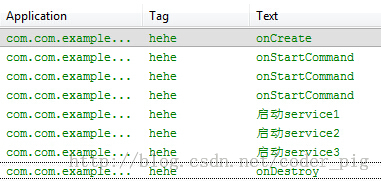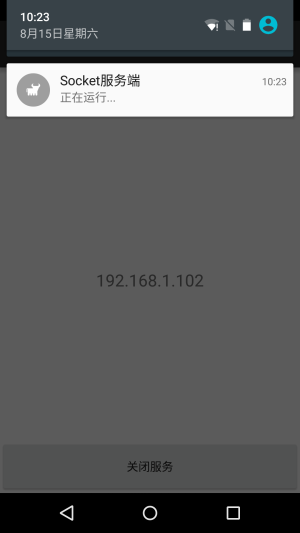# 4.2.2 Service进阶
## 本节引言
> 上节我们学习了Service的生命周期,以及两种启动Service的两种方法, 本节继续来深入了解Service中的IntentService,Service的使用实例: 前台服务与轮询的实现!
## 1.IntentService的使用
在上一节后我们已经知道了如何去定义和启动Service,但是如果我们直接把 耗时线程放到Service中的onStart()方法中,虽然可以这样做,但是很容易 会引起ANR异常(Application Not Responding),而Android的官方在介绍 Service有下面这样一段话:

**直接翻译:**
> 1.Service不是一个单独的进程,它和它的应用程序在同一个进程中
> 2.Service不是一个线程,这样就意味着我们应该避免在Service中进行耗时操作
于是乎,Android给我们提供了解决上述问题的替代品,就是下面要讲的**IntentService**; IntentService是继承与Service并处理异步请求的一个类,在IntentService中有 一个工作线程来处理耗时操作,请求的Intent记录会加入队列
**工作流程:**
> 客户端通过startService(Intent)来启动IntentService; 我们并不需要手动地区控制IntentService,当任务执行完后,IntentService会自动停止; 可以启动IntentService多次,每个耗时操作会以工作队列的方式在IntentService的 onHandleIntent回调方法中执行,并且每次只会执行一个工作线程,执行完一,再到二这样!
再接着是代码演示,网上大部分的代码都是比较Service与IntentService的, 定义足够长的休眠时间,演示Service的ANR异常,然后引出IntentService有多好! 这里就不演示Service了,网上的都是自定义Service,然后在onStart()方法 中Thread.sleep(20000)然后引发ANR异常,有兴趣的可以自己写代码试试, 这里的话只演示下IntentService的用法!
**TestService3.java**
```
public class TestService3 extends IntentService {
private final String TAG = "hehe";
//必须实现父类的构造方法
public TestService3()
{
super("TestService3");
}
//必须重写的核心方法
@Override
protected void onHandleIntent(Intent intent) {
//Intent是从Activity发过来的,携带识别参数,根据参数不同执行不同的任务
String action = intent.getExtras().getString("param");
if(action.equals("s1"))Log.i(TAG,"启动service1");
else if(action.equals("s2"))Log.i(TAG,"启动service2");
else if(action.equals("s3"))Log.i(TAG,"启动service3");
//让服务休眠2秒
try{
Thread.sleep(2000);
}catch(InterruptedException e){e.printStackTrace();}
}
//重写其他方法,用于查看方法的调用顺序
@Override
public IBinder onBind(Intent intent) {
Log.i(TAG,"onBind");
return super.onBind(intent);
}
@Override
public void onCreate() {
Log.i(TAG,"onCreate");
super.onCreate();
}
@Override
public int onStartCommand(Intent intent, int flags, int startId) {
Log.i(TAG,"onStartCommand");
return super.onStartCommand(intent, flags, startId);
}
@Override
public void setIntentRedelivery(boolean enabled) {
super.setIntentRedelivery(enabled);
Log.i(TAG,"setIntentRedelivery");
}
@Override
public void onDestroy() {
Log.i(TAG,"onDestroy");
super.onDestroy();
}
}
```
**AndroidManifest.xml注册下Service**
```
<service android:name=".TestService3" android:exported="false">
<intent-filter >
<action android:name="com.test.intentservice"/>
</intent-filter>
</service>
```
**在MainActivity启动三次服务:**
```
public class MainActivity extends Activity {
@Override
protected void onCreate(Bundle savedInstanceState) {
super.onCreate(savedInstanceState);
setContentView(R.layout.activity_main);
Intent it1 = new Intent("com.test.intentservice");
Bundle b1 = new Bundle();
b1.putString("param", "s1");
it1.putExtras(b1);
Intent it2 = new Intent("com.test.intentservice");
Bundle b2 = new Bundle();
b2.putString("param", "s2");
it2.putExtras(b2);
Intent it3 = new Intent("com.test.intentservice");
Bundle b3 = new Bundle();
b3.putString("param", "s3");
it3.putExtras(b3);
//接着启动多次IntentService,每次启动,都会新建一个工作线程
//但始终只有一个IntentService实例
startService(it1);
startService(it2);
startService(it3);
}
}
```
**运行截图:**

**小结:**
> 当一个后台的任务,需要分成几个子任务,然后按先后顺序执行,子任务 (简单的说就是异步操作),此时如果我们还是定义一个普通Service然后 在onStart方法中开辟线程,然后又要去控制线程,这样显得非常的繁琐; 此时应该自定义一个IntentService然后再onHandleIntent()方法中完成相关任务!
## 2.Activity与Service通信
我们前面的操作都是通过Activity启动和停止Service,假如我们启动的是一个下载 的后台Service,而我们想知道Service中下载任务的进度!那么这肯定是需要Service 与Activity进行通信的,而他们之间交流的媒介就是Service中的onBind()方法! 返回一个我们自定义的Binder对象!
基本流程如下:
* 1.自定义Service中,自定义一个Binder类,然后将需要暴露的方法都写到该类中!
* 2.Service类中,实例化这个自定义Binder类,然后重写onBind()方法,将这个Binder对象返回!
* 3.Activity类中实例化一个ServiceConnection对象,重写onServiceConnected()方法,然后 获取Binder对象,然后调用相关方法即可!
## 3.一个简单前台服务的实现
学到现在,我们都知道Service一般都是运行在后来的,但是Service的系统优先级 还是比较低的,当系统内存不足的时候,就有可能回收正在后台运行的Service, 对于这种情况我们可以使用前台服务,从而让Service稍微没那么容易被系统杀死, 当然还是有可能被杀死的...所谓的前台服务就是状态栏显示的Notification!
实现起来也很简单,最近做的项目刚好用到这个前台服务,就把核心的代码抠出来 分享下:
在自定义的Service类中,重写onCreate(),然后根据自己的需求定制Notification; 定制完毕后,调用startForeground(1,notification对象)即可! **核心代码如下:**
```
public void onCreate()
{
super.onCreate();
Notification.Builder localBuilder = new Notification.Builder(this);
localBuilder.setContentIntent(PendingIntent.getActivity(this, 0, new Intent(this, MainActivity.class), 0));
localBuilder.setAutoCancel(false);
localBuilder.setSmallIcon(R.mipmap.ic_cow_icon);
localBuilder.setTicker("Foreground Service Start");
localBuilder.setContentTitle("Socket服务端");
localBuilder.setContentText("正在运行...");
startForeground(1, localBuilder.getNotification());
}
```
**运行效果截图:**

## 4.简单定时后台线程的实现
除了上述的前台服务外,实际开发中Service还有一种常见的用法,就是执行定时任务, 比如轮询,就是每间隔一段时间就请求一次服务器,确认客户端状态或者进行信息更新 等!而Android中给我们提供的定时方式有两种使用Timer类与Alarm机制!
> 前者不适合于需要长期在后台运行的定时任务,CPU一旦休眠,Timer中的定时任务 就无法运行;Alarm则不存在这种情况,他具有唤醒CPU的功能,另外,也要区分CPU 唤醒与屏幕唤醒!
**使用流程:**
> * **Step 1:获得Service:** AlarmManager manager = (AlarmManager) getSystemService(ALARM_SERVICE);
> * **Step 2:通过set方法设置定时任务** int anHour = 2 * 1000; long triggerAtTime = SystemClock.elapsedRealtime() + anHour; manager.set(AlarmManager.RTC_WAKEUP,triggerAtTime,pendingIntent);
> * **Step 3:定义一个Service** 在onStartCommand中开辟一条事务线程,用于处理一些定时逻辑
> * **Step 4:定义一个Broadcast(广播),用于启动Service** 最后别忘了,在AndroidManifest.xml中对这Service与Boradcast进行注册!
**参数详解:** **set(int type,long startTime,PendingIntent pi)**
> **①type:** 有五个可选值:
> **AlarmManager.ELAPSED_REALTIME:** 闹钟在手机睡眠状态下不可用,该状态下闹钟使用相对时间(相对于系统启动开始),状态值为3;
> **AlarmManager.ELAPSED_REALTIME_WAKEUP** 闹钟在睡眠状态下会唤醒系统并执行提示功能,该状态下闹钟也使用相对时间,状态值为2;
> **AlarmManager.RTC** 闹钟在睡眠状态下不可用,该状态下闹钟使用绝对时间,即当前系统时间,状态值为1;
> **AlarmManager.RTC_WAKEUP** 表示闹钟在睡眠状态下会唤醒系统并执行提示功能,该状态下闹钟使用绝对时间,状态值为0;
> **AlarmManager.POWER_OFF_WAKEUP** 表示闹钟在手机关机状态下也能正常进行提示功能,所以是5个状态中用的最多的状态之一, 该状态下闹钟也是用绝对时间,状态值为4;不过本状态好像受SDK版本影响,某些版本并不支持;
PS:第一个参数决定第二个参数的类型,如果是REALTIME的话就用: SystemClock.elapsedRealtime( )方法可以获得系统开机到现在经历的毫秒数 如果是RTC的就用:System.currentTimeMillis()可获得从1970.1.1 0点到 现在做经历的毫秒数
> **②startTime:** 闹钟的第一次执行时间,以毫秒为单位,可以自定义时间,不过一般使用当前时间。 需要注意的是,本属性与第一个属性(type)密切相关,如果第一个参数对应的闹钟 使用的是相对时间(**ELAPSED_REALTIME**和**ELAPSED_REALTIME_WAKEUP**),那么本属 性就得使用相对时间(相对于系统启动时间来说),比如当前时间就表示为: SystemClock.elapsedRealtime();如果第一个参数对应的闹钟使用的是绝对时间 (RTC、RTC_WAKEUP、POWER_OFF_WAKEUP),那么本属性就得使用绝对时间, 比如当前时间就表示为:System.currentTimeMillis()。
>
> **③PendingIntent:** 绑定了闹钟的执行动作,比如发送一个广播、给出提示等等。PendingIntent 是Intent的封装类。
> 需要注意的是,如果是通过启动服务来实现闹钟提示的话, PendingIntent对象的获取就应该采用Pending.getService (Context c,int i,Intent intent,int j)方法;
> 如果是通过广播来实现闹钟提示的话, PendingIntent对象的获取就应该采用 PendingIntent.getBroadcast (Context c,int i,Intent intent,int j)方法;
> 如果是采用Activity的方式来实现闹钟提示的话,PendingIntent对象的获取 就应该采用 PendingIntent.getActivity(Context c,int i,Intent intent,int j) 方法。
> 如果这三种方法错用了的话,虽然不会报错,但是看不到闹钟提示效果。
**另外:**
从4.4版本后(API 19),Alarm任务的触发时间可能变得不准确,有可能会延时,是系统 对于耗电性的优化,如果需要准确无误可以调用setExtra()方法~
**核心代码:**
```
public class LongRunningService extends Service {
@Override
public IBinder onBind(Intent intent) {
return null;
}
@Override
public int onStartCommand(Intent intent, int flags, int startId) {
//这里开辟一条线程,用来执行具体的逻辑操作:
new Thread(new Runnable() {
@Override
public void run() {
Log.d("BackService", new Date().toString());
}
}).start();
AlarmManager manager = (AlarmManager) getSystemService(ALARM_SERVICE);
//这里是定时的,这里设置的是每隔两秒打印一次时间=-=,自己改
int anHour = 2 * 1000;
long triggerAtTime = SystemClock.elapsedRealtime() + anHour;
Intent i = new Intent(this,AlarmReceiver.class);
PendingIntent pi = PendingIntent.getBroadcast(this, 0, i, 0);
manager.set(AlarmManager.ELAPSED_REALTIME_WAKEUP, triggerAtTime, pi);
return super.onStartCommand(intent, flags, startId);
}
}
```
**AlarmReceiver.java**
```
public class AlarmReceiver extends BroadcastReceiver {
@Override
public void onReceive(Context context, Intent intent) {
Intent i = new Intent(context,LongRunningService.class);
context.startService(i);
}
}
```
## 本节小结:
本节我们继续对Service进行更深入的学习,IntentService以及Service 在实际开发中的两个常用的案例:前台Service的实现,以及Service后台 Service的实现!下一节中我们会继续研究Service的AIDL,跨进程通信, 敬请期待~
**参考文献:** 《第一行代码 Android》—— 郭霖:很好的一本Android入门书!
- 1.0 Android基础入门教程
- 1.0.1 2015年最新Android基础入门教程目录
- 1.1 背景相关与系统架构分析
- 1.2 开发环境搭建
- 1.2.1 使用Eclipse + ADT + SDK开发Android APP
- 1.2.2 使用Android Studio开发Android APP
- 1.3 SDK更新不了问题解决
- 1.4 Genymotion模拟器安装
- 1.5.1 Git使用教程之本地仓库的基本操作
- 1.5.2 Git之使用GitHub搭建远程仓库
- 1.6 .9(九妹)图片怎么玩
- 1.7 界面原型设计
- 1.8 工程相关解析(各种文件,资源访问)
- 1.9 Android程序签名打包
- 1.11 反编译APK获取代码&资源
- 2.1 View与ViewGroup的概念
- 2.2.1 LinearLayout(线性布局)
- 2.2.2 RelativeLayout(相对布局)
- 2.2.3 TableLayout(表格布局)
- 2.2.4 FrameLayout(帧布局)
- 2.2.5 GridLayout(网格布局)
- 2.2.6 AbsoluteLayout(绝对布局)
- 2.3.1 TextView(文本框)详解
- 2.3.2 EditText(输入框)详解
- 2.3.3 Button(按钮)与ImageButton(图像按钮)
- 2.3.4 ImageView(图像视图)
- 2.3.5.RadioButton(单选按钮)&Checkbox(复选框)
- 2.3.6 开关按钮ToggleButton和开关Switch
- 2.3.7 ProgressBar(进度条)
- 2.3.8 SeekBar(拖动条)
- 2.3.9 RatingBar(星级评分条)
- 2.4.1 ScrollView(滚动条)
- 2.4.2 Date & Time组件(上)
- 2.4.3 Date & Time组件(下)
- 2.4.4 Adapter基础讲解
- 2.4.5 ListView简单实用
- 2.4.6 BaseAdapter优化
- 2.4.7ListView的焦点问题
- 2.4.8 ListView之checkbox错位问题解决
- 2.4.9 ListView的数据更新问题
- 2.5.0 构建一个可复用的自定义BaseAdapter
- 2.5.1 ListView Item多布局的实现
- 2.5.2 GridView(网格视图)的基本使用
- 2.5.3 Spinner(列表选项框)的基本使用
- 2.5.4 AutoCompleteTextView(自动完成文本框)的基本使用
- 2.5.5 ExpandableListView(可折叠列表)的基本使用
- 2.5.6 ViewFlipper(翻转视图)的基本使用
- 2.5.7 Toast(吐司)的基本使用
- 2.5.8 Notification(状态栏通知)详解
- 2.5.9 AlertDialog(对话框)详解
- 2.6.0 其他几种常用对话框基本使用
- 2.6.1 PopupWindow(悬浮框)的基本使用
- 2.6.2 菜单(Menu)
- 2.6.3 ViewPager的简单使用
- 2.6.4 DrawerLayout(官方侧滑菜单)的简单使用
- 3.1.1 基于监听的事件处理机制
- 3.2 基于回调的事件处理机制
- 3.3 Handler消息传递机制浅析
- 3.4 TouchListener PK OnTouchEvent + 多点触碰
- 3.5 监听EditText的内容变化
- 3.6 响应系统设置的事件(Configuration类)
- 3.7 AnsyncTask异步任务
- 3.8 Gestures(手势)
- 4.1.1 Activity初学乍练
- 4.1.2 Activity初窥门径
- 4.1.3 Activity登堂入室
- 4.2.1 Service初涉
- 4.2.2 Service进阶
- 4.2.3 Service精通
- 4.3.1 BroadcastReceiver牛刀小试
- 4.3.2 BroadcastReceiver庖丁解牛
- 4.4.2 ContentProvider再探——Document Provider
- 4.5.1 Intent的基本使用
- 4.5.2 Intent之复杂数据的传递
- 5.1 Fragment基本概述
- 5.2.1 Fragment实例精讲——底部导航栏的实现(方法1)
- 5.2.2 Fragment实例精讲——底部导航栏的实现(方法2)
- 5.2.3 Fragment实例精讲——底部导航栏的实现(方法3)
- 5.2.4 Fragment实例精讲——底部导航栏+ViewPager滑动切换页面
- 5.2.5 Fragment实例精讲——新闻(购物)类App列表Fragment的简单实现
- 6.1 数据存储与访问之——文件存储读写
- 6.2 数据存储与访问之——SharedPreferences保存用户偏好参数
- 6.3.1 数据存储与访问之——初见SQLite数据库
- 6.3.2 数据存储与访问之——又见SQLite数据库
- 7.1.1 Android网络编程要学的东西与Http协议学习
- 7.1.2 Android Http请求头与响应头的学习
- 7.1.3 Android HTTP请求方式:HttpURLConnection
- 7.1.4 Android HTTP请求方式:HttpClient
- 7.2.1 Android XML数据解析
- 7.2.2 Android JSON数据解析
- 7.3.1 Android 文件上传
- 7.3.2 Android 文件下载(1)
- 7.3.3 Android 文件下载(2)
- 7.4 Android 调用 WebService
- 7.5.1 WebView(网页视图)基本用法
- 7.5.2 WebView和JavaScrip交互基础
- 7.5.3 Android 4.4后WebView的一些注意事项
- 7.5.4 WebView文件下载
- 7.5.5 WebView缓存问题
- 7.5.6 WebView处理网页返回的错误码信息
- 7.6.1 Socket学习网络基础准备
- 7.6.2 基于TCP协议的Socket通信(1)
- 7.6.3 基于TCP协议的Socket通信(2)
- 7.6.4 基于UDP协议的Socket通信
- 8.1.1 Android中的13种Drawable小结 Part 1
- 8.1.2 Android中的13种Drawable小结 Part 2
- 8.1.3 Android中的13种Drawable小结 Part 3
- 8.2.1 Bitmap(位图)全解析 Part 1
- 8.2.2 Bitmap引起的OOM问题
- 8.3.1 三个绘图工具类详解
- 8.3.2 绘图类实战示例
- 8.3.3 Paint API之—— MaskFilter(面具)
- 8.3.4 Paint API之—— Xfermode与PorterDuff详解(一)
- 8.3.5 Paint API之—— Xfermode与PorterDuff详解(二)
- 8.3.6 Paint API之—— Xfermode与PorterDuff详解(三)
- 8.3.7 Paint API之—— Xfermode与PorterDuff详解(四)
- 8.3.8 Paint API之—— Xfermode与PorterDuff详解(五)
- 8.3.9 Paint API之—— ColorFilter(颜色过滤器)(1/3)
- 8.3.10 Paint API之—— ColorFilter(颜色过滤器)(2-3)
- 8.3.11 Paint API之—— ColorFilter(颜色过滤器)(3-3)
- 8.3.12 Paint API之—— PathEffect(路径效果)
- 8.3.13 Paint API之—— Shader(图像渲染)
- 8.3.14 Paint几个枚举/常量值以及ShadowLayer阴影效果
- 8.3.15 Paint API之——Typeface(字型)
- 8.3.16 Canvas API详解(Part 1)
- 8.3.17 Canvas API详解(Part 2)剪切方法合集
- 8.3.18 Canvas API详解(Part 3)Matrix和drawBitmapMash
- 8.4.1 Android动画合集之帧动画
- 8.4.2 Android动画合集之补间动画
- 8.4.3 Android动画合集之属性动画-初见
- 8.4.4 Android动画合集之属性动画-又见
- 9.1 使用SoundPool播放音效(Duang~)
- 9.2 MediaPlayer播放音频与视频
- 9.3 使用Camera拍照
- 9.4 使用MediaRecord录音
- 10.1 TelephonyManager(电话管理器)
- 10.2 SmsManager(短信管理器)
- 10.3 AudioManager(音频管理器)
- 10.4 Vibrator(振动器)
- 10.5 AlarmManager(闹钟服务)
- 10.6 PowerManager(电源服务)
- 10.7 WindowManager(窗口管理服务)
- 10.8 LayoutInflater(布局服务)
- 10.9 WallpaperManager(壁纸管理器)
- 10.10 传感器专题(1)——相关介绍
- 10.11 传感器专题(2)——方向传感器
- 10.12 传感器专题(3)——加速度/陀螺仪传感器
- 10.12 传感器专题(4)——其他传感器了解
- 10.14 Android GPS初涉
- 11.0《2015最新Android基础入门教程》完结散花~
